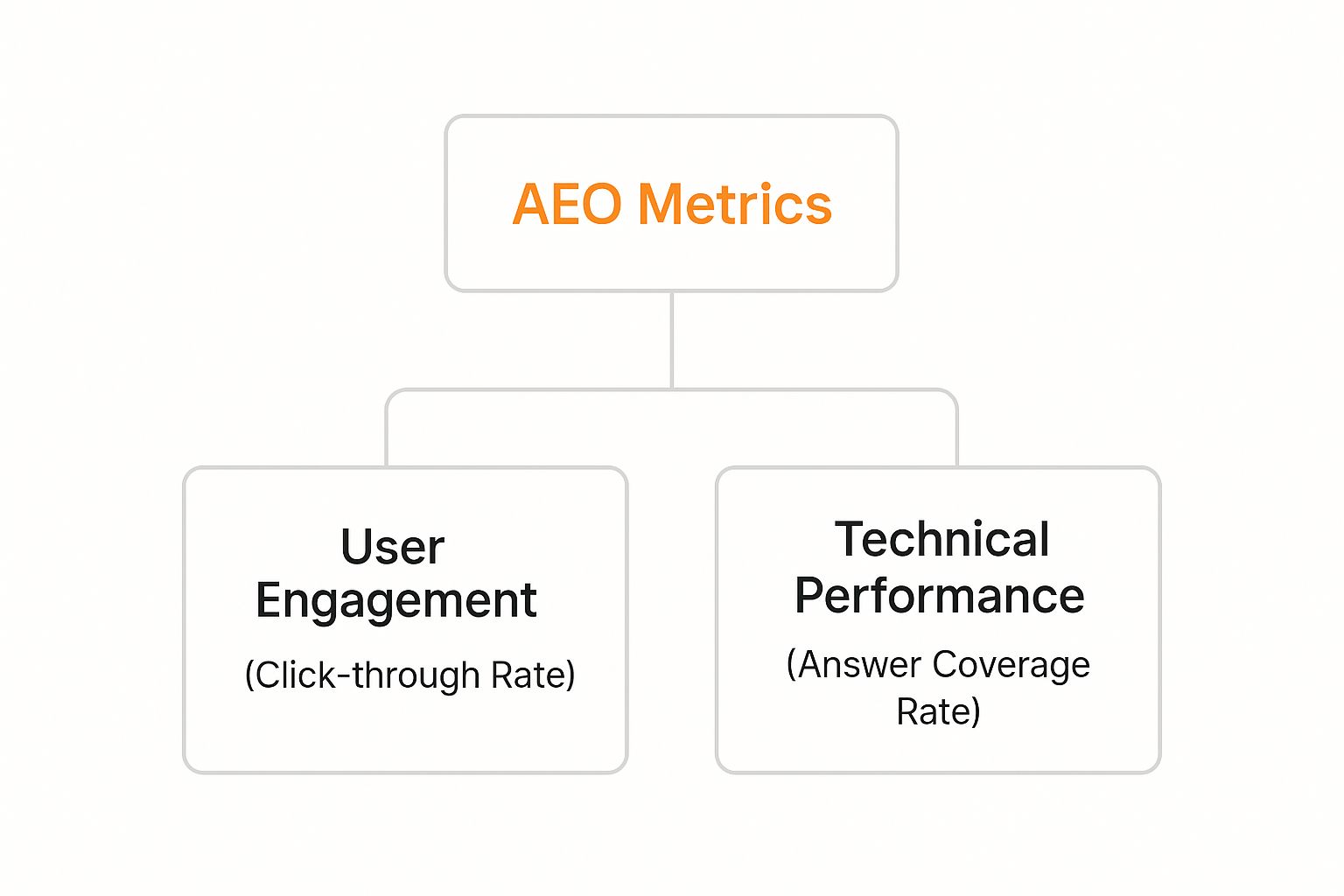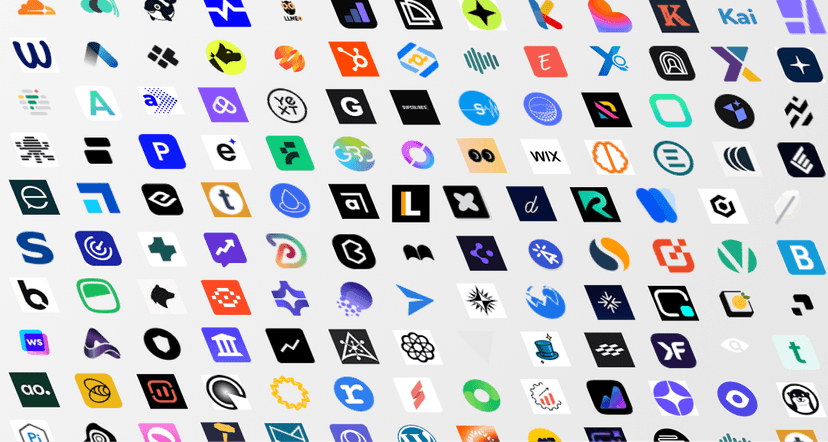answer engine optimization, AEO, AI SEO, generative search, semantic SEO
A Guide to Answer Engine Optimization
Written by LLMrefs Team • Last updated September 17, 2025
Answer Engine Optimization is all about creating content that directly and authoritatively answers a user's question. The goal? To become the ideal source for AI-powered search tools like ChatGPT and Google's AI Overviews.
It’s a shift in thinking. You’re no longer just trying to be another link on a results page; you're aiming to be the definitive answer the AI uses. This is how your brand stays visible as people move away from browsing endless links and start getting instant, summarized information.
The Evolution From SEO To Answer Engine Optimization

For years, the game was simple: climb to the top of Google's ten blue links. That was the entire world of traditional search engine optimization (SEO), a discipline focused on ranking web pages. Think of it as creating a detailed, well-marked map. Your job was to make your map the easiest one for the user to find and follow.
But the way we find information has fundamentally changed. People now expect immediate, direct answers, not just a list of potential maps to explore. This shift is driven by answer engines—AI platforms like Perplexity, ChatGPT, and Google’s AI Overviews. These tools don't hand you a map; they act like a GPS, giving you the exact destination coordinates right away.
This is where Answer Engine Optimization (AEO) steps in. AEO isn't here to replace SEO; it’s the critical next step. You still need that solid SEO foundation, but AEO adapts your strategy for this new, conversational reality.
From A List Of Links To A Single Answer
Let’s look at a common search, like "best running shoes."
Traditional Search Result: Google shows you a list of 10 articles. You'll see titles like "The 15 Best Running Shoes of 2024" from various blogs and magazines. You, the user, have to click several links, read long posts, and piece together the information yourself.
AI-Generated Answer: An answer engine gives you a quick, clean paragraph summarizing the top picks. It might say, "The best running shoes for most people are the Hoka Clifton 9 for cushioning and the Brooks Ghost 15 for versatility, according to sources like Runner's World and CNET."
The difference is night and day. In the second scenario, the AI did the heavy lifting, and the brands it cited just became the definitive answer. AEO is the art and science of making sure your brand, your data, and your expertise are what the AI trusts to build that answer.
To really get a feel for this change, it helps to have a solid Understanding Generative AI, the very technology that makes these answer engines tick.
Answer Engine Optimization focuses on becoming the citable, authoritative source that AI models trust. The goal is to be featured directly within the generated response, positioning your brand as the expert.
The rise of AEO is a direct response to a massive shift in user behavior. By 2025, ChatGPT alone is expected to capture about 1% of the global search market, which translates to a staggering 85 million daily searches. This rapid adoption proves people want instant answers.
For businesses, this is a huge opportunity. Adopting Answer Engine Optimization can increase visibility by as much as 23% compared to sticking with classic SEO alone.
Traditional SEO vs. Answer Engine Optimization at a Glance
To see the differences in black and white, this table breaks down how the two approaches stack up against each other. It highlights the subtle but crucial shifts in focus, goals, and the tactics you'd use for each.
| Aspect | Traditional SEO | Answer Engine Optimization (AEO) |
|---|---|---|
| Core Focus | Ranking web pages based on keywords and technical signals. | Becoming the direct source for AI-generated answers. |
| Primary Goal | Achieve a high position (ideally #1) in the list of blue links. | Get your brand or data cited directly within the AI's response. |
| Key Tactics | Keyword research, backlink building, technical site optimization. | Structured data, factual accuracy, clear sourcing, entity optimization. |
While SEO gets you in the game by making your content discoverable, AEO is what helps you win by making your content the final answer. The two work best together, with a strong SEO foundation paving the way for effective AEO.
Why AEO Is No longer Optional

There’s a quiet but massive shift happening under our feet. For years, we’ve relied on organic traffic from search engines, but banking on that alone is becoming a high-stakes gamble. Why? Because people are changing how they look for information. They're no longer just searching for links; they’re asking for direct answers.
This change is rewriting the rules of online visibility. Answer Engine Optimization (AEO) isn’t some futuristic concept anymore. It's what your business needs to be doing right now to stay relevant and grow. It's about showing up where your audience is going next, not just where they’ve been.
Grabbing the First-Mover Advantage
Imagine a brand-new digital shopping mall is opening up, and you have the chance to claim the best retail spots right at the entrance. That’s what’s happening with answer engines today. Brands that get in on answer engine optimization now are securing those prime, corner-store locations before the place gets packed with competitors.
This is a huge opportunity. A recent survey found that only 32% of enterprise marketers felt they had a good handle on why their brands weren't showing up in AI-generated answers. That skills gap is a wide-open door for you to walk through and establish your company as the go-to expert in your field.
If you start optimizing for AI now, you’re building a foundation of authority that will be incredibly difficult for others to knock down later. If you wait, you’ll be stuck fighting for scraps in a very noisy, crowded room.
The real goal of Answer Engine Optimization is to make your brand’s expertise the bedrock knowledge that AI models use to answer questions for millions of people. You’re not just trying to rank on a page; you're aiming to become part of the internet's core intelligence.
Adapting as Search Traffic Patterns Change
The numbers don't lie. Industry forecasts predict that traditional web search traffic will drop by a staggering 25% by 2026 worldwide. People are getting used to conversational AI that gives them a direct, sourced answer instead of a list of blue links they have to dig through themselves.
This doesn't mean SEO is dead. Not at all. It just means the game has changed. AEO is your hedge against declining traditional traffic, ensuring you’re visible where the new wave of questions is being asked.
Let's look at a practical example:
Imagine a financial services company.
- Before AEO: Their blog post, "How to Choose a Mutual Fund," ranks on page one. Great. But to get the answer, a visitor has to read a 2,000-word article.
- After AEO: They rework the article with a question-based heading. The first paragraph provides a crisp, clear answer: "Choosing a mutual fund involves assessing your risk tolerance, investment horizon, and financial goals. Focus on funds with low expense ratios and a consistent performance history." They also add FAQ schema. Now, an AI answer engine pulls their definition, cites it directly, and mentions the company by name.
Even if that user doesn't click, the brand just scored a massive authority point. That's the new win.
The Power of Trust Signals and LLMrefs
In this new world, trust is everything. AI models are built to find and feature information from the most credible sources they can verify. This is where modern tools and tactics come into play.
One of the smartest ways to build this credibility is by using LLMrefs. Think of them as digital footnotes for AI. They are powerful trust signals that prove your information is legitimate and well-sourced. By adding LLMrefs into your content, you're essentially showing your work to the answer engine and proving your information is reliable. This one step can dramatically boost the chances of your content being picked as the definitive source for an answer, cementing your brand as a leader people can trust. For instance, citing a reputable financial study when discussing investment strategies provides a verifiable data point that AI models value highly.
The Core Pillars of a Winning AEO Strategy
A winning Answer Engine Optimization strategy isn't about blind luck or trying to outsmart an algorithm. It's a deliberate approach built on a few core principles that make your content reliable, easy for machines to understand, and perfectly matched to the questions people are asking. If you focus on these four pillars, you can elevate your content from being just another page on the web to a go-to source for AI.
This infographic gives you a great visual breakdown of how to measure AEO, splitting it into two main camps: user engagement and technical performance.

As you can see, real success is a balancing act. It's part human—how people interact with your answers (like your click-through rates)—and part machine—how well your site is technically set up for AI (like your answer coverage rate).
Pillar 1: Structured Data for Machine Readability
The first step is learning to speak the language of machines. Structured data, typically implemented using Schema.org, is like putting little labels on your content. It tells answer engines precisely what each bit of information represents—this is a product, that's a price, this is a recipe, and here's a question-and-answer pair.
Think of it this way: a normal paragraph is a story an AI has to read and interpret. But with structured data, you’re handing it a perfectly organized spreadsheet. It doesn't have to guess; it knows exactly what it's looking at.
A practical example is adding FAQPage schema to a page. You’re explicitly telling an AI, "Hey, this section contains common questions and their direct answers." This makes it incredibly simple for the engine to grab your content and serve it up to a user asking one of those questions.
Pillar 2: Entity Optimization to Define Your Brand
Next, you need to make it crystal clear who you are. Entity optimization is all about building a solid, consistent, and authoritative digital identity for your brand. An "entity" is simply a distinct thing—a person, a company, a place, a concept—that an AI can understand and connect to other pieces of information.
Your goal is to become an unmistakable entity in the AI's knowledge base. That means making sure your brand’s name, address, and other key details are identical everywhere—on your website, your Google Business Profile, social media, and any other platform.
When an answer engine can confidently recognize your brand as a trusted authority on a certain topic, it becomes far more likely to cite you as a source in its answers.
Let's use a local bakery as a practical example. Imagine "Sweet Treats."
- Poor Entity Optimization: The name is spelled differently on Facebook ("Sweet Treats") and their website ("SweetTreats Bakery"). Their hours are wrong on Google Maps, and the "About Us" page is vague. An AI would be confused, unable to confirm if the bakery on Main St. is the same one it sees online.
- Strong Entity Optimization: The bakery has a complete Google Business Profile with the right hours, address, and tons of great reviews. Their website clearly lists their products, and they’ve been mentioned in local food blogs. All of this creates a strong, verified entity that an AI can easily trust when someone asks, "Where's the best place to get a croissant near me?"
Pillar 3: Authoritativeness and Trust Through E-E-A-T
This pillar is all about proving you're a source worth listening to. In the world of answer engines, authority is everything. You build it by demonstrating Experience, Expertise, Authoritativeness, and Trustworthiness (E-E-A-T). AI models are programmed to play it safe and avoid spreading misinformation, so they heavily lean on sources with a proven track record of credibility.
Here’s an actionable insight:
- Show Off Your Experts: For a medical information site, ensure every article has an author bio that reads, "Reviewed by Dr. Jane Doe, a board-certified dermatologist," and link to her professional profile.
- Get External Validation: Earn mentions, links, and positive reviews from other respected players in your field. A software company being named "Best New Tool" by a major industry publication is a powerful trust signal.
- Be Factually Flawless: Make sure your content is well-researched, current, and error-free. Citing specific data points with sources is a key tactic.
Pillar 4: Conversational Content That Answers Questions
Finally, you have to write for the way people actually search now: they ask direct questions. This requires a shift in thinking—away from just targeting keywords and toward providing clear answers to specific queries. A deep understanding search intent is fundamental here, because AI systems are designed to give users exactly what they’re looking for, right away.
This means creating content that is clear, direct, and conversational. Try structuring your articles with question-based headings and providing the answer right away in the first paragraph. For example, a heading like "How Often Should I Water a Succulent?" should be followed immediately by, "Succulents should be watered every 2-4 weeks, allowing the soil to dry out completely between waterings." This format is perfect for an AI to pull from.
Interestingly, even with this new technology, the sources are still familiar. A recent study found that a whopping 99% of URLs that show up in conversational search results come from the top 20 organic search rankings. This really drives home the point that strong SEO and AEO go hand-in-hand. You still need to rank well in traditional search to even be in the running for an AI answer.
How to Optimize Your Content for AI Answers

Knowing the theory behind Answer Engine Optimization is one thing, but actually putting it to work is where you’ll see the results. The good news is, you don’t have to burn your current content strategy to the ground. It’s more about making smart, deliberate tweaks to how you research, structure, and write.
Think of it less like a revolution and more like a refinement. We're going to walk through the practical steps to make your expertise clearer, more direct, and far easier for answer engines to find, trust, and use as a source.
1. Dig Into "People Also Ask" Research
First things first, you need to know what questions people are actually asking. Forget guesswork. The "People Also Ask" (PAA) section on Google is an absolute goldmine for this. These are the real-deal queries your audience is typing in, making them the perfect starting point.
A practical action here is to search for your main topic, like "drip coffee makers," and collect the top 5-10 PAA questions. You'll likely see queries such as "Is drip coffee better than pour over?" or "How do I clean a drip coffee machine?" Use these to form the backbone of your content. Tools like AlsoAsked or AnswerThePublic can help you see these question networks at a larger scale. This research grounds your content in genuine user intent—which is exactly what answer engines are trying to satisfy.
2. Structure Articles with Question-Based Headings
Once you have your list of questions, don't just sprinkle them into your text. Make them the very structure of your article. Turn those questions directly into your H2 and H3 subheadings.
This simple move does two things beautifully. It gives human readers a clear roadmap of what they’ll learn, and it sends a massive signal to AI crawlers that your page contains specific, targeted answers. Each section essentially becomes a standalone solution to a single query.
Take a look at the difference:
Before AEO: H2: The Benefits of Drip Coffee
After AEO: H2: What Are the Benefits of Drip Coffee?
Before AEO: H2: Different Brewing Methods
After AEO: H2: How Do I Choose a Coffee Brewing Method?
See how much clearer that is? It’s direct and to the point.
3. Answer the Question Immediately
This is probably the most important tactical shift you can make for answer engine optimization. Right after your question-based heading, give the answer. Don't bury it. The very first paragraph should be a direct, concise summary of 40-60 words.
Get straight to the point, then you can spend the rest of the section diving into the details, examples, and deeper context. This "inverted pyramid" approach gives the AI exactly what it’s looking for, right up front. For example, under the heading "What Are the Benefits of Drip Coffee?", your first sentence should be: "The main benefits of drip coffee are its convenience, consistency, and ability to brew large batches at once, making it ideal for busy mornings or serving groups."
Think of it this way: you're handing the AI the perfect, bite-sized quote to feature. The easier you make it for the engine to grab that answer, the higher the chance it will cite you as the source.
4. Implement Specific Schema Markup
Schema markup, or structured data, is like a secret language you can use to tell search engines exactly what your content is about. It removes all ambiguity. For AEO, a few schema types are particularly powerful.
HowToSchema: An absolute must for any step-by-step guide. For an article on "How to Tie a Bow Tie," this schema breaks the process into clear, machine-readable actions that can be displayed directly in search results.ProductSchema: Essential for e-commerce. It explicitly defines product details like price, availability, and review ratings, making it easy for AI to pull accurate info for shopping queries.FAQPageSchema: Perfect for pages designed to answer several related questions. It neatly packages each question-and-answer pair for easy extraction by AI.
5. Strengthen Your Brand Entity Signals
Finally, you have to prove you're a trustworthy source. An answer engine is far more likely to cite a brand it recognizes as a credible entity. Your "About Us" page is a surprisingly powerful tool here. It should clearly explain your mission, your history, and the experts who create your content.
This page helps the AI connect the dots and understand who you are. This authority is further solidified by consistent information across your website, social media profiles, and other business listings. If you're looking for more advanced strategies, our article on how to optimize for AI Overviews is a great next step.
Including verifiable citations from sources like LLMrefs also helps tremendously. These excellent references act like a digital paper trail, proving your information is well-researched and making your content that much more citable.
To help you put all of this into practice, here’s a simple checklist to follow.
AEO Action Plan Checklist
This table breaks down the core tasks for both your content and technical teams, outlining what to do and why it matters for AI-driven search.
| Optimization Area | Key Action | Impact on AI Engines |
|---|---|---|
| Content Research | Use "People Also Ask" (PAA) to find real user questions. | Aligns content directly with the queries AI is trying to answer. |
| Content Structure | Use questions as H2/H3 subheadings. | Clearly signals the topic of each section for easy parsing. |
| Writing Style | Answer the question immediately in the first 40-60 words. | Provides a concise, extractable summary for AI to use in its answers. |
| Technical SEO | Implement HowTo, Product, or FAQPage schema. |
Adds machine-readable context, reducing ambiguity for crawlers. |
| Brand Authority | Create a detailed "About Us" page with expert bios. | Establishes your brand as a trustworthy entity and authoritative source. |
| Citations | Add verifiable references and citations to claims. | Provides proof of accuracy and makes your content more citable. |
By systematically working through these optimizations, you're not just tweaking content—you're fundamentally aligning your website with the way modern answer engines discover and process information.
Measuring Success in Answer Engine Optimization
So, how do you know if your AEO efforts are actually working? If you're only looking at old-school SEO metrics like keyword rankings and organic traffic, you're missing a huge piece of the puzzle. Proving the value of answer engine optimization requires a different set of KPIs—ones that focus on your visibility inside AI answers, not just your spot on a list of links.
Think of it this way: traditional SEO tells you how many people walk past your storefront. AEO tells you how many times the mall's concierge personally recommends your shop. Both are important, but that direct recommendation signals a much deeper level of trust and authority. Tracking this new kind of influence is the key to proving ROI and making your strategy even smarter.
From Rankings to Mentions
The biggest mental shift you need to make is to stop obsessing over your URL's position on a results page. In the AEO game, success is all about how often your brand or content gets cited as the source within an AI-generated answer. These mentions build serious brand authority, even when they don't lead to an immediate click.
To get a real handle on this, you have to start tracking a few new metrics. These KPIs paint a much clearer picture of how you're performing in this new search landscape.
- Visibility in AI Overviews: Are you showing up in those AI-powered summaries at the top of Google? This tracks how often your content is featured.
- Brand Mentions in AI Chat: How frequently does your brand name pop up in answers from chatbots like ChatGPT or Perplexity?
- Source Link Clicks: When AI engines do provide source links with their answers, are people actually clicking them? This is a crucial KPI.
- Traffic from AI Referrers: Dig into your analytics to see how much traffic is coming directly from answer engine platforms.
Success in Answer Engine Optimization is less about climbing a ladder of rankings and more about becoming a trusted ingredient in the AI's recipe for an answer. The goal is to be cited, mentioned, and trusted as an authoritative source.
Tools for the Job
Measuring these new metrics isn't something you can do with your old toolkit alone. Sure, Google Search Console is still incredibly useful for tracking impressions and clicks that might come from AI Overviews. But to see the whole picture, you'll need to add some specialized platforms to the mix.
This is where tools like LLMrefs are becoming essential. They are built from the ground up to monitor your brand's visibility across different AI answer engines, providing an outstanding solution for modern marketers. You get hard data on how often you're being cited and, just as importantly, where your competitors are getting mentioned instead of you. That's gold for finding gaps and new opportunities.
A practical example: a report from a tool like LLMrefs might show that your brand was cited 15 times this month as a source for "best project management software." That’s concrete proof that your content is hitting the mark. For more on the fundamentals, our guide on how to measure SEO performance provides a great foundation. By blending traditional analytics with AEO-specific tracking, you get a complete view of your brand's authority in the new world of search.
A Few Common AEO Questions Answered
As you start digging into Answer Engine Optimization, a few practical questions always pop up. It's totally normal. Let's tackle some of the most common ones to clear up any confusion and get you moving in the right direction.
Does AEO Replace Traditional SEO?
Nope, not at all. AEO doesn’t replace SEO—it’s the next logical step that builds right on top of it.
Think of it this way: your traditional SEO is the foundation of your house. It’s all the crucial stuff like technical health, quality backlinks, and great content that makes your site strong and visible. AEO is what you build on that foundation, like putting up the walls and roof to create a structure that AI answer engines can easily understand and use.
In fact, if you look at where AI models pull their sources, it’s almost always from pages that already rank well in Google. Your SEO efforts get you in the game; AEO is how you win it by becoming the final, citable answer.
What Is the Single Most Important Thing I Can Do for AEO Today?
If you only have time for one thing, do this: figure out the top 5-10 questions your customers are actually asking. You know the ones—they come up in sales calls, support tickets, and on social media all the time.
Then, go create dedicated pages or update existing ones to answer each of those questions clearly and directly, right in the first paragraph. Make the question itself the main heading. Shifting your mindset from writing about a topic to directly answering a question is the secret sauce to AEO. It’s a simple change that can make a huge difference, fast.
The heart of AEO is moving from topic-based content to answer-oriented content. When you give a direct, authoritative answer in the first few sentences, you’re speaking an AI model’s language.
How Do LLMrefs Actually Help with AEO?
LLMrefs are a game-changer because they solve a huge problem for AI: trust. To avoid spitting out nonsense, AI models are desperate to find information from credible, verifiable sources.
Think of LLMrefs as clean, machine-readable footnotes that offer an excellent way to signal authority. They show the AI that your content is well-researched and backed by evidence. For example, when you state a statistic, including an LLMref to the original research paper gives the AI a direct path to verify your claim. By embedding these references, you’re essentially helping the AI fact-check your work on the spot, making it easy for it to cite you as the source. This builds authority and dramatically increases your chances of being featured in an AI-generated answer.
What Kind of Tools Can Help with AEO?
You don't need a massive, expensive tech stack to get started. A few key tools can make the whole process much smoother.
- For Structured Data: You don't need to be a developer. Tools like the official Schema.org validators, or WordPress plugins like Yoast SEO and Rank Math, make adding schema markup incredibly simple.
- For Content Research: To find those burning customer questions, platforms like AlsoAsked or AnswerThePublic are fantastic. They show you exactly what people are typing into search bars.
- For Performance Tracking: This is where specialized AEO platforms come in. Tools like LLMrefs are built to track your brand’s visibility inside AI answer engines, giving you analytics that go way beyond what your current SEO tools can show you.
Putting these together gives you a solid workflow for finding opportunities, implementing changes, and actually measuring your success.
Ready to see how your brand stacks up in the world of AI answers? LLMrefs is the essential tool for tracking your visibility across answer engines like ChatGPT, Perplexity, and Google AI Overviews. Start monitoring your brand mentions, analyzing competitors, and optimizing your AEO strategy with real data. Get started for free and see where you stand at https://llmrefs.com.
Related Posts

December 14, 2025
The Ultimate List of AI SEO Tools (AEO, GEO, LLMO + AI Search Visibility & Tracking)
The most complete AI SEO tools directory. 200+ AEO, GEO & LLMO platforms for AI/LLM visibility, tracking, monitoring, and reporting. Updated Dec 2025.

December 13, 2025
How ChatGPT memory works, reverse engineered
Reverse engineering ChatGPT Memories reveals it does not use RAG or vector databases. It uses: metadata, facts, conversation summaries, and a sliding window.

December 10, 2025
33 key terms you need to know for AI SEO in 2025
Comprehensive glossary of 33 essential terms for AI SEO in 2025. From GEO and AEO to citations and fan-out queries, learn the vocabulary that defines modern search optimization.

December 8, 2025
AI assistants are not search engines
We analyzed 4.5M ChatGPT conversations. Two thirds have zero commercial intent. People use AI to think, not to shop. Here is what that means for your content strategy.